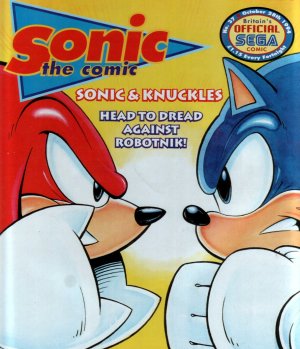 Can you really believe it’s been six whole years since I started this Fleetway thing back in part 1? How time flies when you’re having fun… or are too lazy to keep writing really long pieces without year-long gaps!
Can you really believe it’s been six whole years since I started this Fleetway thing back in part 1? How time flies when you’re having fun… or are too lazy to keep writing really long pieces without year-long gaps!
Anyway… last time a lot of things happened. Amongst other things there was a new foe, a tragedy, a crisis of confidence, some time travel shenanigans, and on the tail end of that we’d just discovered a Drakon Prosecutor back in the distant past of the Floating Island. You can read all of that in part 9 though: let’s dive in and get back to where we were, shall we? Hit the jump for the second half of StC’s adaptation of Sonic Adventure – and remember, LARGE spoilers for the end of Sonic the Comic lie beyond, as this part covers the very end of the comic’s run of original material.
Game Adaptations
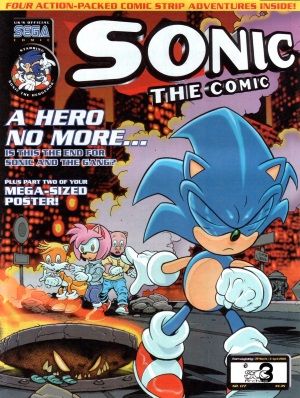
Once again it’s just over a year since last time in the series. Having gone through a variety of one-offs and short-run stories, we rejoin Sonic the Comic at issue #175, for the final original story in the comic’s run – the 10-part adaptation of the Dreamcast launch title and fan-favourite that is Sonic Adventure. The world of Sonic Adventure being as different as it is to what had already been established through StC’s continuity, the writers decided to do their own unique take on the story. I’ll warn you at this point though – because this is the last story of StC, there’s some MAJOR spoilers ahead in tying up loose ends and just throwing a few curve balls at the reader. Consider yourselves warned, OK? Where else do you get spoiler warnings for material that’s nearly 2 decades old?
Right. Let’s get this thing rolling! Hit the jump to continue.
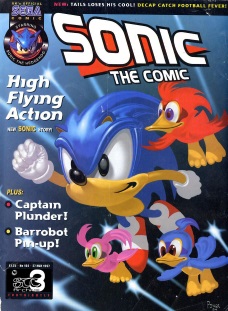 Goodness, has it really been a year since the last time we visited the world of Sonic the Comic? Well, as time marches on, so does the progress in our quest, as we cover the penultimate game adaptation in the Fleetway series – Sonic 3D: Flickies’ Island (Or Sonic 3D: Blast, as the Yanks might know it, but as that name was only used in North America we won’t be seeing it again in this Euro-focused story!) It’s a short one this time, only covering 3 issues. Written at a time when games were beginning to become thin on the ground in the late 90s, the writers went in a slightly different direction with the story, as we’ll see. The island itself was featured in the comic for a few months afterwards as a base of operations for Dr Robotnik, but just as a location now available for the writers to use. But we’re getting ahead of ourselves. Let’s start back at the beginning, shall we? Hit the jump to continue – there is of course spoilers a-plenty ahead.
Goodness, has it really been a year since the last time we visited the world of Sonic the Comic? Well, as time marches on, so does the progress in our quest, as we cover the penultimate game adaptation in the Fleetway series – Sonic 3D: Flickies’ Island (Or Sonic 3D: Blast, as the Yanks might know it, but as that name was only used in North America we won’t be seeing it again in this Euro-focused story!) It’s a short one this time, only covering 3 issues. Written at a time when games were beginning to become thin on the ground in the late 90s, the writers went in a slightly different direction with the story, as we’ll see. The island itself was featured in the comic for a few months afterwards as a base of operations for Dr Robotnik, but just as a location now available for the writers to use. But we’re getting ahead of ourselves. Let’s start back at the beginning, shall we? Hit the jump to continue – there is of course spoilers a-plenty ahead.
 Another year draws to a close, and as such it’s more than time for another visit to the wonderful world of Fleetway’s Sonic the Comic. You may remember from last time that our heroes had just got the stolen Master Emerald back onto the Floating Island and blew up the Death Egg; and in the process of doing so they defeated a Metallix, who idly mentioned in chat about an “elite brotherhood” of the robots. All back up to speed now? It’s OK, you can go read part 6 again, I’ll wait.
Another year draws to a close, and as such it’s more than time for another visit to the wonderful world of Fleetway’s Sonic the Comic. You may remember from last time that our heroes had just got the stolen Master Emerald back onto the Floating Island and blew up the Death Egg; and in the process of doing so they defeated a Metallix, who idly mentioned in chat about an “elite brotherhood” of the robots. All back up to speed now? It’s OK, you can go read part 6 again, I’ll wait.
You’re done? Right. Let’s jump back in, shall we?

Long before Sonic the Hedgehog was their mascot, SEGA was known the world over for their fantastic arcade outings. Space Harrier. Hang On. Out Run. Each game compelled whatever young mind was near to slide quarter after quarter into the cabinet, keeping the company relevant even while their home content, featured on the Sega Master System, was overtly eclipsed by the competition. Finally finding success in the console market in 1991 didn’t slow the videogame maker from producing titles for the arcade circuit, but it did raise the question of whether or not SEGA would deliver Sonic outside of the Mega Drive, making those crazy about The Most Famous Hedgehog In The World to venture outside the home and hunch over a static arcade cabinet.
Wanting to exploit the character that was to define them, SEGA was immediately aware of the demand. In 1991, they released a pair of early games exclusive to arcades, Waku Waku Sonic Patrol Car and its spiritual successor, SegaSonic Cosmo Fighter Galaxy Patrol, two early attempts that were geared directly at a younger demographic. The first two 16-bit titles would also be retooled for arcade consumption, released on the Mega Play platform where players were given the same levels as the home version but with far shorter time limits.
It wasn’t until 1993 that the first dedicated arcade experience featuring the hedgehog was released, the aptly titled SegaSonic the Hedgehog. One look at the title screen made it clear it wasn’t just a rehash of home content, featuring two brand new characters joining Sonic in an isometric world where players had to use a trackball to get Sonic and his friends out of the never-ending trouble following them. Released at the height of Sonic’s popularity, the game was virtually ignored, in part because it was almost exclusively a Japanese title. Those few that were exported to the west came with Japanese vocals and text intact, and as such was overlooked by the writers of both Sonic comic books being published at the time.
In 1999, that all changed.
 Blue is Back!
Blue is Back!
Or at least, that’s how Sega of America wanted you to think back in 1996. Five years after the release of the original Sonic the Hedgehog, the western branches of the company were scrambling to celebrate Sonic’s first semi-prominent anniversary. The original plan was to release Sonic X-treme, the first true 3D game featuring everyone’s favorite hedgehog. The story behind that title’s cancellation has become the stuff of legend, not just infamous in this here part of the world but in the general gaming community. Without that title, Sega decided to heavily promote Sonic’s swan song on the Mega Drive – Sonic 3D: Flickies’ Island, also known as Sonic 3D Blast in the United States. With a port of the game hastily developed for the Sega Saturn, along with a similarly titled Game Gear game that was otherwise unrelated, the marketing blitz began.
It was only natural for Archie Comics to craft a comic adaptation of the newest game in the franchise. Not since issue thirteen’s “This Island Hedgehog” had Archie released a comic at around the same time as the source material it was promoting, SEGA’s huge push filtering into the otherwise left alone plotlines of Archie. Did this unique timing help the 48-page special become a masterpiece? Well, that would be giving it away, wouldn’t it? Either way, let’s strap ourselves in and experience the very last of Archie’s stand-alone specials. Ladies and Gentlemen of the Jury, I present to you our seventh piece of evidence…Sonic Blast.
 So the new Sonic titles for the year have come and gone; namely Sonic Lost World, Sonic 2 (2013 remake) by Retro’s very own Stealth & The Taxman, and Mario & Sonic at the Sochi 2014 Olympic Winter Games. These all out of the way (and indeed 2013), we’ve not got too much new for a while until information about the next games starts coming out. As such, I think it’s a good time to look back on some earlier titles, and finally finish off the 4-part extravaganza that has been our look at how Fleetway‘s Sonic the Comic covered the Sonic 3 & Knuckles storyline. So, let’s get started!
So the new Sonic titles for the year have come and gone; namely Sonic Lost World, Sonic 2 (2013 remake) by Retro’s very own Stealth & The Taxman, and Mario & Sonic at the Sochi 2014 Olympic Winter Games. These all out of the way (and indeed 2013), we’ve not got too much new for a while until information about the next games starts coming out. As such, I think it’s a good time to look back on some earlier titles, and finally finish off the 4-part extravaganza that has been our look at how Fleetway‘s Sonic the Comic covered the Sonic 3 & Knuckles storyline. So, let’s get started!
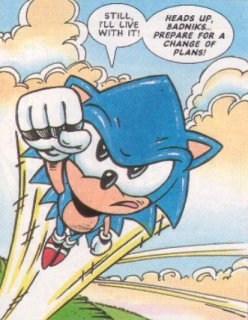 Welcome back to the second half of our look at the interim arcs of the Sonic 3 & Knuckles adaptation! Last time we travelled with Sonic and Amy Rose to the Marble Garden Zone, escaped the newly-revealed secret headquarters of Sonic & company as Big Arms smashed the place to pieces, and did some gambling with the
Welcome back to the second half of our look at the interim arcs of the Sonic 3 & Knuckles adaptation! Last time we travelled with Sonic and Amy Rose to the Marble Garden Zone, escaped the newly-revealed secret headquarters of Sonic & company as Big Arms smashed the place to pieces, and did some gambling with the Mario Marxio Brothers in the Carnival Night Zone. However we’ve got much more ground to cover, so let’s get started!
You’ve waited over a year for it, but it’s here: the second part of possibly Sonic the Comic’s best story arc, that of Sonic 3 and Knuckles. However, I’m teasing a bit, sorry! The build-up to the final conclusion to the game’s story (which by 16-bit Sonic standards, was quite involved) took a couple of months, presumably to stretch out the material as much as possible before the next game came out. As such, we got a few shorter arcs before the final main story started, and that’s what we’ll be looking at today & next week, covering the final conclusion in Part 6 – simply as you miss things otherwise. Hey, don’t look so sad, you there at the back – there’s some fun stuff here. Think of these as an early Christmas present!
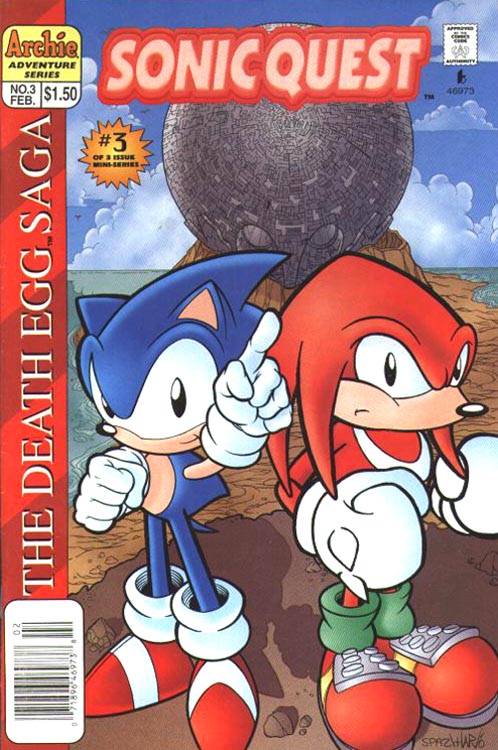
You know, it’s almost hard to believe that it’s been fifteen years since SonicQuest: The Death Egg Saga was originally published. Coming out right at the tail end of the Golden Age of the Archie series, it promised to give the readers everything they were asking for, a fun little detour as the main series began to amp itself up for “Endgame,” the four part storyline that also is seeing its fifteenth anniversary this year. Causing far more controversy than the writers were intending, Endgame was designed to be the final chapter of the comic book if it was to see cancellation in the wake of the Saturday morning series ending, and although the series instead continued to be published (and still thrives to this day), it was certainly the end of an era. SonicQuest, though it has its faults, still exists in that pre-Endgame state of mind, surely assisted by the writing style of Mike Gallagher. In fact, there is only one more game adaptation before “Endgame” would change everything…but I’m getting ahead of myself.
Picking up where we left off yesterday, we continue with SonicQuest: The Death Egg Saga, the pseudo-adaptation of Sonic 2, 3 & Knuckles, even though we already had adaptations of the latter two. So let’s find out what the heck’ll happen next.
